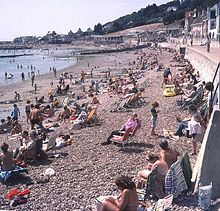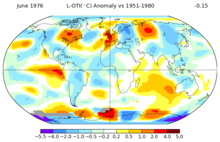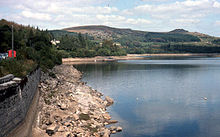Was there a 1976 drought following the major heatwave?
 Lyme Regis Beach, Dorset, Baronial 1976 | |
| Areas | British Isles |
|---|---|
| Start date | 23 June 1976 |
| Cease date | 27 Baronial 1976[one] |
| Height temperature | 35.9 °C (96.vi °F), recorded at Cheltenham, Gloucestershire on three July 1976 |
A period of unusually hot summer weather occurred in the British Isles during the summer of 1976. At the same fourth dimension, there was a severe drought on the islands of Great britain and Ireland.[ii] [iii] Information technology was i of the driest, sunniest and warmest summers (June/July/Baronial) in the 20th century, although the summertime of 1995 is at present regarded equally the driest. But a few places registered more than one-half their average summer rainfall. In the CET record, it was the warmest summer in the serial until being surpassed in the 21st century. It was the warmest summer in the Aberdeen area since at least 1864, and the driest summer since 1868 in Glasgow.[four]
The health furnishings of the oestrus contributed to mortality displacement during the year. Wild fauna and vegetation furnishings were also observed. The British government implemented h2o rationing to mitigate the impact of the drought. It remains a reference point for unusually hot summers in the state.
Heatwave and drought effects [edit]
Heathrow had xvi consecutive days over xxx °C (86 °F) from 23 June to viii July[5] and for 15 consecutive days from 23 June to 7 July temperatures reached 32.two °C (90 °F) somewhere in England. Furthermore, five days saw temperatures exceed 35 °C (95 °F). On 28 June, temperatures reached 35.6 °C (96.1 °F) in Southampton, the highest June temperature recorded in the Great britain. The hottest day of all was 3 July, with temperatures reaching 35.9 °C (96.6 °F) in Cheltenham.[ commendation needed ]
The great drought was due to a very long dry menses. The summer and fall of 1975 were very dry out, and the wintertime of 1975–76 was exceptionally dry, as was the leap of 1976; indeed, some months during this period had no pelting at all in some areas.[ citation needed ]
The drought was at its nigh astringent in August 1976 and in response Parliament passed the Drought Human action 1976 to ration water.[half dozen] Parts of the southward due west went 45 days without any rain in July and Baronial. Equally the hot and dry out weather continued, devastating heath and forest fires broke out in parts of Southern England. l,000 copse were destroyed at Hurn Forest in Dorset. Crops were badly hit, with £500 one thousand thousand worth of crops failing. Food prices subsequently increased past 12%.[7]
In the last week of Baronial 1976, days after Denis Howell was appointed 'Government minister for Drought', astringent thunderstorms brought pelting to some places for the first time in weeks. September and Oct 1976 were both very wet months, bringing to an cease the nifty drought of 1975–1976.
The Haweswater reservoir had just 10% of its water left; people walked dryshod on its bed sixty feet (eighteen one thousand) below its normal h2o level. The site of the flooded village of Mardale Green was dry.[8] Ladybower reservoir in Derbyshire stale out and revealed the flooded villages of Ashopton and Derwent, information technology was possible to make out the village layout and garden walls.
In Republic of ireland the temperature reached 32.5 °C (ninety.5 °F) in County Offaly on 29 June 1976.[ix] There were also gorse fires in County Wicklow.

June 1976 GISS Surface Temperature Analysis Global Maps from GHCN v3 Data
Health impact [edit]
The 1976 heatwave is understood to have been the cause of 20% "excess deaths" and there was a significant increase in hospital emergency admissions from 24 June to 8 July 1976 than for the aforementioned period in 1975 or 1974.[10] This compares to 59% excess deaths for the 2003 heatwave.[11]
Ecological impact [edit]
Massive swarms of seven-spotted ladybirds (Coccinella septempunctata) occurred across the country, with the British Entomological and Natural History Society estimating that past late July 23.65 billion of them were swarming across the southern and eastern coasts of England. The population explosion occurred considering a warm bound had meant there were many aphids, the ladybirds' nutrient prey; as the hot weather stale the plants on which the aphids fed, the aphid populations complanate, causing the ladybirds to swarm to endeavour to find food elsewhere.[12]
The extensive fires paradoxically helped preserve many areas of heathland that had been condign scrubland through natural succession considering of reduced grazing pressure; the but long-term effect of the fires on Dorset heathlands was a change in the composition of scrub.[13] The impacts of the extended drought on mature trees, especially beech, were still axiomatic in United kingdom of great britain and northern ireland woodlands in 2013.[14]
Government response [edit]

Burrator Reservoir in Devon, July 1976. Many reservoirs, like this one, were at a very depression level
The outcome on domestic water supplies led to the passing of a Drought Human activity by Parliament[6] and Minister for Drought, Denis Howell, was appointed.[15] There was some water rationing and public standpipes in some afflicted areas.[ citation needed ] Reservoirs were at an extremely low level, every bit were some rivers. The rivers Don, Sheaf, Shire Brook and Meers Beck (all in Sheffield) all ran completely dry, without a driblet of h2o in any of them, as well as Frecheville Pond and Carterhall Pond.
Longer term, the UK Department of the Environment realised it needed more data most the storage capacity and other properties of British aquifers, every bit sources of groundwater.[ citation needed ]
Comparisons [edit]

The highest temperature during the 1976 oestrus wave was 35.9 °C (96.half dozen °F), 0.8 °C below the record at the time of 36.7 °C (98.1 °F) set on ix August 1911.[16] As of 2022, 1976 has the 13th hottest day in Britain history.[17] In the Cardinal England Temperature series, 1976 is the hottest summer for more than than 350 years. The average temperature over the whole summer (June, July, August) was 17.77 °C (63.99 °F), compared to the average for the unusually warm years between 2001–2008 of sixteen.30 °C (61.34 °F).[eighteen] As of 2022, the hottest years in the series are 2003, 2006 and 2014.[19]
The summer became embedded in the national psyche, with subsequent heatwaves in 1995,[20] 1997,[21] 2003, 2006[22] and 2022,[23] [24] all using 1976 equally a benchmark. The 1976 heatwave was a rarity within its decade. Heatwaves worldwide, have since get more frequent and intense due to climate alter.[17] [23]
See too [edit]
- Drought in the United kingdom
- 1955 United kingdom heat wave
- Summertime of 1976 (Europe)
- 2003 European rut wave
- 2006 European heat wave
- 2022 United Kingdom heat wave
References [edit]
- ^ "Trevor Harley Habitation Page weather consciousness language dreams". Archived from the original on iv September 2018. Retrieved 4 September 2018.
- ^ "The drought of 1976". BBC News. Archived from the original on 20 March 2012. Retrieved twenty May 2011.
- ^ Cox, Evelyn Cox (1978). The Great Drought of 1976. Hutchinson, Readers Spousal relationship Group.
- ^ "1975 - 1999". Haul.org.uk. Archived from the original on 3 October 2016. Retrieved 15 December 2016.
- ^ "Hot spell - Baronial 2003". Met Office. Archived from the original on 5 April 2011. Retrieved fifteen December 2016.
- ^ a b http://politicsuk.net Archived five July 2018 at the Wayback Machine (total text)
- ^ https://web.archive.org/web/20090708200802/http://archive.thisiswiltshire.co.united kingdom of great britain and northern ireland/2001/7/iv/214711.html. Archived from the original on eight July 2009. Retrieved 1 January 2008.
- ^ Ian, Harrison (2008). Britain from Above. London: Pavilion Books. p. 169. ISBN978-i-862058-34-7.
- ^ "Republic of ireland'due south Hottest Solar day". RTÉ Archives. Archived from the original on 19 July 2018. Retrieved xviii July 2018.
- ^ "Mortality and Morbidity in Birmingham during the 1976 Heatwave". QJM. 1 January 1980. Archived from the original on 20 September 2016. Retrieved 15 Dec 2016.
- ^ [ane] Archived xxx June 2015 at the Wayback Machine
- ^ "Could the ladybird plague of 1976 happen again?". BBC News Online. five March 2016. Archived from the original on 16 October 2016. Retrieved 15 December 2016.
- ^ "Britain: The Role of Fire in the Ecology of Heathland in Southern Britain (IFFN No. 18 - Jan 1998)". Fire.uni-freiburg.de. Archived from the original on 16 July 2011. Retrieved 15 December 2016.
- ^ "United kingdom forests still feeling the impacts of 1976 drought - BBC News". Bbc.co.uk. 24 July 2013. Archived from the original on 27 May 2016. Retrieved fifteen December 2016.
- ^ Longman, Phil (17 March 2004). "Was 1976 all it's cracked upward to be?". BBC News. Archived from the original on 16 February 2009. Retrieved 20 May 2011.
- ^ "Hot spell August 1990" (PDF). Met Office. 30 October 2012. Archived (PDF) from the original on xx July 2021. Retrieved 20 July 2022.
- ^ a b "U.k. heatwave: How do temperatures compare with 1976?". BBC News. 18 July 2022. Archived from the original on 19 July 2022. Retrieved 19 July 2022.
- ^ [two] Archived 7 Apr 2008 at the Wayback Machine
- ^ "Met Office Hadley Center observations datasets". www.metoffice.gov.uk. Archived from the original on nineteen July 2022. Retrieved 19 July 2022.
- ^ "The summer of '76". BBC News. 20 March 1998. Archived from the original on 24 February 2007. Retrieved 20 May 2011.
- ^ "Government warns of h2o shortages". BBC News. 4 November 1997. Archived from the original on 5 January 2003. Retrieved twenty May 2011.
- ^ Coughlan, Sean (xiv July 2006). "Is 2006 the new 1976". BBC News . Retrieved 20 May 2011.
- ^ a b Simons, Paul (xviii July 2022). "This UK heatwave is not like the summer of 1976. We've never seen anything similar it". The Times. ISSN 0140-0460. Archived from the original on nineteen July 2022. Retrieved 19 July 2022.
- ^ Gilbert, Ella (19 July 2022). "Yes, U.k. had a heatwave in 1976. No, it was zero like the crisis nosotros're in at present". The Guardian. Archived from the original on 19 July 2022. Retrieved 19 July 2022.
Bibliography [edit]
- The Nifty Drought of 1976. Evelyn Cox (1978). Hutchinson, Readers Spousal relationship Group, ISBN 978-0091332006
Source: https://en.wikipedia.org/wiki/1976_British_Isles_heat_wave
Posted by: cilleyladon1973.blogspot.com



0 Response to "Was there a 1976 drought following the major heatwave?"
Post a Comment